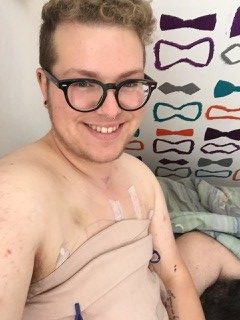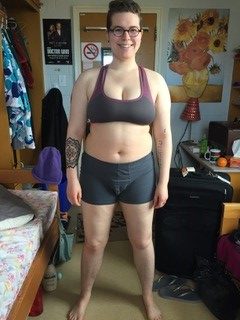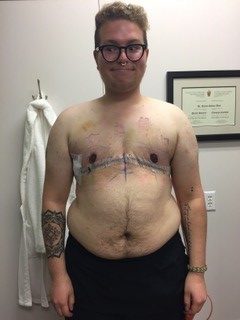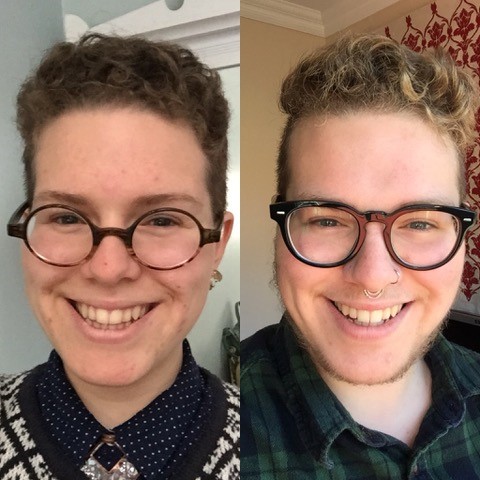Before Olivier Hébert attended St. Thomas University, he barely knew what transgender was. He only knew the common media-driven narrative of feeling trapped inside someone else’s body.
But by the beginning of his fourth year, he identified as non-binary and had undergone chest-reconstruction surgery.
It took one year of paperwork and consultations, but on Sept. 6, Hébert walked into the Sackville Memorial Hospital. After four hours of surgery, he was transformed.
“It immediately felt right,” he said.

From coming out as a gay woman in 2010 when he was in Grade Nine, to walking out of the hospital after his top surgery, it was a long journey.
The transformation
When Hébert was 14 and still went by the name Hannah, he came out to his friends and family as a young gay woman.
For him, it was an overwhelmingly positive experience. He told all his immediate and extended family and friends, who had various accepting responses.
“When I told [one of my best friends that] I had figured it out, she pumped her fists in the air and screamed, ‘Yes!’ in the middle of the cafeteria,” he said.
However, it wasn’t until he arrived at STU that the concept of transgender started popping up in his mind. He met people who were non-binary, who identified as neither fully female or fully male, and sometimes a bit in between. Non-binary became the term that Hébert started going by and still uses to this day.
After his partner came out as transgender, he changed how he identified himself to the public.
“That’s probably when things started snowballing slowly. It was when he came out that I changed how I identified myself to the public.”
He started identifying as queer.
Then, the summer after his first year, Hébert started feeling uncomfortable with his body.
“I noticed that I was feeling uncomfortable with my chest showing. I wanted to be perceived differently.”
Because of this, he started binding his chest. It was an everyday task just to cover things up.
“Dressing before top surgery was about cloaking things … That androgyny that I enjoy, I wanted it further than just an androgynous woman.”


As a result, he started taking more steps towards transitioning. He considered using a different name, he started hiding his gender and he started taking testosterone.
It was this final step that made Hébert sure he wanted top surgery.
“I knew that having a flat chest was important to my gender expression and me feeling comfortable in the world.”
The process
Top surgery isn’t achieved through a decision with instant results. Hébert had to undergo a year-long process before he actually went to the operating table.
Although he says the process was relatively short compared to the wait times of other surgeries, there were some other shortcomings of New Brunswick’s health system which slowed things down.
“I have felt often out of the loop with how to best care for myself,” said Hébert.
Throughout the process of consultations and appointments, he felt some information was not given, not explained or it was assumed that he should already be informed, despite not having gone through the surgery before.
In addition, the coverage implemented by the provincial government failed to cover liposuction, which costs another $3000 — a step Hébert considers common for transgender men.
The coverage cost is even worse for women, as many of the surgeries are considered “cosmetic”, like laser hair removal, and not covered at all.
Finally, there was the fear of being one of the first people to undergo top surgery in New Brunswick, which just became covered by Medicare this past year. This meant doctors may not be experienced with the process.


“You may have to be prepared for the fact that you may sort of be a guinea pig,” Hébert said.
However, Hébert was satisfied with the experience and the operation in the end. The doctors and nurses tried their best to make him feel safe and comfortable. The process to get approved was also relatively easy. He was happily surprised.
“I think a lot of these people don’t have the knowledge they should but they are doing a wonderful job, in my experience, of being accepting and making sure that their patient is comfortable.”
The result
Now, six weeks after top surgery, Hébert walks around more confident and comfortable than ever before.
He feels he can express his more feminine attributes without fear of being mis-gendered and he is grateful for STU’s acceptance throughout his whole journey and transition.
After surgery, Hébert slept for 18 hours. When he woke up, he was overcome by a flood of emotions.
“I was excited. I was tired.”
While he healed and was eventually able to take his bandages off and look at himself in the mirror, he realized something.


“This was how I’ve been picturing myself ever since I first realized I was trans, even before that,” he said.
And now, other people can perceive him in the way which he truly wants to be perceived.
Thanks to this surgery, Hébert now feels at home in his body.
“That’s the point. That’s what we’re striving for.”

